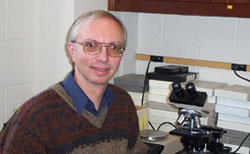 Fall 2006 |
|
| PREVIOUS | PAGE 1 | |
News
from the poster session at Purdue University |
 |
The poster session for the 2006 ABLE conference at Purdue University took place in the main entrance to the biology building, Lily Hall. The eight presentations were well attended. Lively one-on-one conversation between presenters and workshop participants indicated that the poster session was a valued part of the conference experience. David Hougen-Eitzman, from Carleton College, generated considerable interest with his enthusiastic explanations on how he incorporates statistics into his introductory biology program. His idea is to build skill sets and tools by incorporating graphing and data analysis into introductory biology labs. Gary Lange, from Saginaw Valley State University, presented his innovative lab on using rats to teach mammalian reproduction. Students observe male and female sexual behaviors as a way to integrate their knowledge with traditional reproductive anatomy and physiology. The group from North Carolina State University has been an active contributor to the poster session in past years. This year was no exception. Marianne Niedzlek-Feaver presented her work on "innorts", an imaginary set of organisms that resemble lemurs. Innorts serve as a tool for DNA fingerprint analysis through web simulations. Betty Black presented the trials and tribulations of using hand held (Palm) computers for collaborative and interactive learning. She found that students found them helpful for some modes of analysis, but traditional computers were preferred by students in other learning modes. As an extension of their work on promoting active learning, Marianne and Betty displayed a third poster on their on-going efforts to utilize the internet for active concept exploration of cell structure and function. Mary Mulcahy, from University of Pittsburgh at Bradford, showed how she uses inexpensive motion detector cameras designed for hunters to identify locations of wild game. Mary has students use the equipment to collect data on animal populations on the edge and interior of forested areas. Clever idea. Pam Connerly, from Indiana University East, revealed how she has students actively involved doing student-designed projects on yeast growth. She has them center the projects around variables that include heat shock, nutrient limitation, temperature change, and UV treatment. Spread over three labs of her Cell Biology course, students develop growth curves and do SDS-PAGE gels to detect protein pattern changes. Mike Martin (John Carroll University) presented his novel approach to bloodless blood type. He uses a PCR amplification of an ABO gene exon in combination with restriction enzyme fragmentation of the product to uniquely identify genotypes.
|
|
| PREVIOUS | PAGE 1 | |